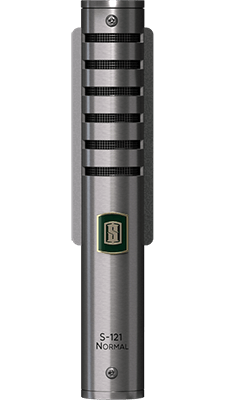Meet Our

Meet the ML-1 Microphone
The ML-1 microphone is the centerpiece of the Virtual Microphone System. This large diaphragm mic has a shock-mounted, gold-sputtered, 6-micron capsule and a state-of-the-art FET circuit path that ensures the most linear, flat, and clean ‘blank canvas’ response.
Combined with the Virtual Microphone System, the ML-1 is capable of replicating the sound the tone of nearly two dozen iconic mics that have helped shape the sound of audio over time

Meet the ML-2 Microphone
The ML-2 microphone is a small diaphragm studio microphone that can also recreate the tone of an entire mic locker of instrument mics.
From famous dynamic mics to cardioid models of classic ribbons and even other large- and small-diaphragm favorites, the ML-2 is an incredibly versatile tool that makes recording and post-processing a breeze.

YOUR NEW INSTRUMENT MIC LOCKER

S-47F
This famous German FET microphone model is known for round highs, fat mids, and huge low end. It’s a standard on kick drum and bass cab, but also sounds great on toms.

S-67
This is actually a model of a large diaphragm tube mic! It has smooth and slightly dark highs, thick mids, and big lows. Great on room mics, overheads, toms, snare, guitars, basses, and everything else!

S-7
This is a dynamic mic that became famous as a broadcasting microphone, but its present mids make it ideal for all sorts of instruments such as kick, toms, snare, guitars, bass, and more.

S-E20
This is a model of a dynamic microphone that became popular in the seventies. It has a very even frequency response while remaining fat-sounding, so it can be useful on all sort of different sources – from vocals and electric guitar to kick drum.

S-57 Vintage
This model is a recreation of an early 80’s dynamic 57, perhaps one of the most famous dynamic microphones in audio history. It’s known for its punchy midrange and smooth top end, which is why it is a top choice on guitar and snare drum.

S-Custom Snare
This is a modified version of the S-57, with added curves from famous EQ’s to enhance the sound, producing the ultimate polished snare sound.

S-57 Modern
A brand new dynamic 57, this mic sounds very similar to the vintage model but with slightly smoother mids and more sizzly highs.

S-112
This is a model of a famous modern kick drum microphone. It has a classic “bouncy” midrange and fat low end.

S-112B
This is the same emulated mic as the S-112 captured from inside the kick drum itself.

S-421
Another classic dynamic mic, this model is perfect on toms, kick, guitar cab, bass cab, and horns. It has thick low mids and punchy lows.

S-Custom Tom
This is a modified version of the S-421 that adds more highs and lows, and has less low mid, creating the ultimate tom sound for both rack and floor.

S-414 Normal
This is a model of one of the most famous FET large diaphragm mics. It has clear punchy mids, slightly extended highs, and a very fat low end. It’s perfect on overheads, guitar cabs, bass cabs, toms, and horns.

S-414 Dynamic
This emulation is the same as the S-414 Normal, only it has been optimized for use with the ML-2 when it’s in Dynamic mode. Use this model and the ML-2’s Dynamic mode when micing very loud sources.

S-12
This is a model of a vintage kick drum microphone. It has a crisp top, fat low mid, and warm bottom end.

S-Custom Kick
This is a modified version of the S-12 that adds more attack and punch, with less low mids and more defined lows.

S-121 Normal
This is a cardioid model of the classic ribbon mic, and like the real thing, it has fat lows and slightly dark highs, making it perfect on horns, strings, room mics, guitar cabs, and overheads.

S-121 Dynamic
This emulation is the same source microphone as the S-121 Normal, only it has been optimized for use with the ML-2 when it’s in Dynamic mode. Use this model and the ML-2’s Dynamic mode when micing very loud sources.

S-222
This is a model of a famous small diaphragm tube mic. It’s bright but not harsh, with a smooth midrange and flat low end. It’s ideal for drum overheads, acoustic guitars, and string instruments.

S-451
This is a model of a famous small diaphragm condenser that is smooth and clear, with a beautiful high end. It’s great on snare, overheads, hi hat, toms, and guitar cabs if paired with one of the dynamic models.
Latency Free Processing
The Virtual Microphone System software consists of the Classic Tubes microphone module, which contains eight classic tube microphone models, the FG-73 British discrete preamp module, and the FG-76 German tube preamp module. None of these processing blocks add any latency to the audio signal, so if you use a low latency interface with VMS you can track through the VMS software without any audible monitoring delay.
To accomplish this, we recommend a Thunderbolt or fast USB interface, recording at 96khz with the lowest buffer size possible. The combination of the 96khz sampling rate and low buffer size ensures the lowest possible latency.
FAQ
What’s a Studio Recording Microphone?
Studio recording microphones are specialized devices designed for capturing sound with high fidelity in a controlled environment. These microphones vary greatly in design, functionality, and application, ranging from models that excel in recording vocals to those suited for instruments.
Key features often include a wide frequency response, high sensitivity, and the ability to handle various sound pressure levels without distortion, making them essential tools for producing professional-quality recordings.
What is a Virtual Microphone System (VSM)?
A virtual microphone system is a technology that uses a combination of hardware and software to emulate the sound characteristics of various high-end studio microphones. This system typically includes a physically modeled microphone and a software plugin that digitally reproduces the tonal qualities of classic and vintage microphones.
Users can switch between different mic models in the software, allowing them to achieve a wide range of sounds without needing multiple physical microphones, thus providing versatility and cost-effectiveness in studio settings
What system requirements are necessary for a Slate Digital Studio Microphone?
The system requirements for using Slate Digital Studio Microphones with the Virtual Microphone System software include a compatible VST, AU, or AAX host software, and a computer with sufficient processing power to handle real-time audio processing.
It is recommended to have a modern CPU and a good amount of RAM to ensure smooth operation. Additionally, a stable and compatible audio interface is required to connect the microphone to your computer. Operating system compatibility typically includes recent versions of both Windows and macOS.
Which slate digital condenser mic is best for a home studio?
For a home studio, the Slate Digital ML-1 would be an excellent choice among condenser microphones. It offers versatility through its Virtual Microphone System, allowing you to emulate various high-end studio microphones.
This feature is particularly beneficial in a home studio setting, where budget and space might limit the number of physical microphones one can have.
The ML-1’s ability to deliver multiple microphone sounds from a single unit enhances both the quality and variety of recordings you can achieve.
System Requirements
macOS
- Minimum: macOS 10.15 or later
- Recommended: macOS 11 or later
- Intel or Apple Silicon (M1) Processor
- AU, VST2, VST3, or AAX 64-bit host
Windows
- Windows 10 or 11
- Intel or AMD Processor, 4GB RAM
- VST2, VST3, or AAX 64-bit host
iLok Requirements
The All Access Pass can be used with iLok Cloud and does not require an iLok USB dongle. You will just need an active internet connection to use iLok Cloud.
Perpetual "Buy Now" individual plugin licenses require an iLok 2 or iLok 3 USB dongle.



